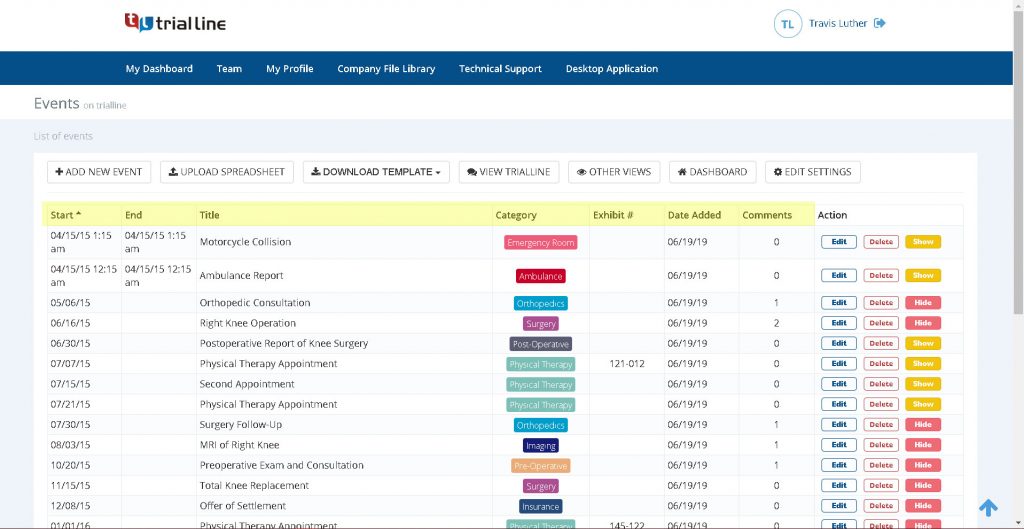AI medical chronology is changing how medical records are managed, analyzed, and used in legal and healthcare settings. It organizes large volumes of medical documents into a structured timeline, making it easier to track key medical events.
Legal and medical professionals benefit from faster case preparation and more accurate summaries of a patient’s medical history.
However, while AI-powered medical systems reduce human error and save time, concerns about accuracy, data security, and ethical issues remain.
In this article, you will learn about the benefits and limitations of AI medical chronology, its impact on the medical and legal fields, and whether it is the right solution for handling complex medical histories.
Don’t Get Lost in Medical Records—Book a Demo with TrialLine!
What Are Medical Chronologies?
Medical chronologies organize a patient’s medical history into a structured timeline, highlighting key events such as diagnoses, treatments, and procedures.
They help legal professionals, insurance companies, and healthcare providers analyze medical conditions and their progression.
Traditionally, creating a medical chronology is a time-consuming process that involves reviewing pages of medical records and manually structuring medical data.
AI-powered medical chronology systems aim to simplify this process by automating the extraction, classification, and arrangement of medical information.
Several advanced technologies support AI-driven medical chronology:
- Natural language processing (NLP) – AI extracts relevant information from unstructured medical text, including doctors’ and clinical notes.
- Machine learning (ML) – AI learns from past data to improve its ability to summarize medical records with high accuracy.
- Optical character recognition (OCR) – Converts scanned medical documents into editable text for analysis.
How AI Processes Comprehensive Medical Chronology
AI-powered systems analyze large volumes of medical records by breaking them down into structured data points. Here’s how the process works:
- Data extraction – AI scans medical documents and identifies key events such as hospital visits, test results, and treatments.
- Classification – Categorizes medical records by date, type, and relevance, distinguishing between diagnoses, procedures, and medication history.
- Chronological ordering – The system arranges medical data into a structured timeline so it is easier to follow a patient’s medical history.
- Summarization – AI generates a medical record summary for a concise overview of the detailed information in the records.
Benefits of Using AI for Medical Chronologies in Legal Practice
By automating the medical record review process, AI systems:
Reduce Labor Intensive Documentation Burdens
Manual medical record review is a tedious aspect of legal work. Law firms spend weeks analyzing large volumes of medical data, slowing down case progression.
AI automates this process by identifying key events within medical data, eliminating the need for manual sorting.
For law firms handling multiple cases, AI reduces administrative workload.
Instead of assigning teams to summarize medical records, AI tools generate detailed chronologies with high accuracy. This allows attorneys to focus on legal arguments instead of spending hours reviewing complex medical information.
Simplify Complex Case Preparation
Personal injury lawyers often deal with medical records that document multiple hospital visits, treatments, and procedures.
Manually reviewing these records can slow down case preparation and increase the risk of human error. AI-powered medical chronology simplifies this process by automatically extracting pertinent information from doctors’ and clinical notes, lab reports, and other documents.
With AI-generated case overviews, attorneys can quickly understand a client’s medical history without manually searching through hundreds of pages.
A structured timeline of medical events also helps identify critical details, establish liability, and strengthen legal arguments.
Strengthen Risk Control
AI medical chronology improves risk assessment in personal injury cases and other legal matters involving medical records.
By identifying inconsistencies or missing key information, AI reduces the chances of presenting weak or incomplete evidence. If medical events are missing from the records, attorneys can take corrective steps before presenting their case.
Law firms that rely on manual medical record review risk overlooking critical information that could affect a case’s outcome.
AI helps attorneys detect discrepancies in medical data early in the review process, strengthening legal strategies and minimizing errors. This allows lawyers to build stronger cases and have more confidence in the accuracy of their medical record summaries.
Keep Data Secure
Sensitive medical information must be handled in accordance with HIPAA-compliant data practices.
Law firms must make sure medical records remain confidential and protected from unauthorized access. AI-powered chronology tools include robust security measures that encrypt and securely store medical data, reducing the risk of privacy violations.
By automating medical records, AI also reduces the human handling of sensitive information, further lowering the risk of security breaches.
Law firms using AI-powered medical chronologies can assure clients that their medical documents are protected throughout the litigation process.
Optimize Decision-Making for Better Outcomes
AI-generated medical record summaries provide a clearer view of a client’s medical history, helping attorneys make informed legal decisions.
When preparing for personal injury cases, lawyers need exact information to support claims and defenses. AI simplifies this by structuring medical data into clear timelines that highlight key events relevant to the case.
Attorneys benefit from better organization and trial presentation of medical records, which improves legal arguments and strengthens courtroom strategy.
Limitations of AI in Generating Medical Chronologies
While AI medical chronology provides advantages for law firms, it also has limitations that legal professionals must consider.
Lack of Contextual Understanding
AI can process data quickly, but it lacks the ability to fully interpret the context behind medical records. Legal cases require a deep understanding of medical events and their implications.
While AI can arrange medical records chronologically, it may fail to recognize how specific conditions, treatments, or physician notes relate to liability or damages. Attorneys must still review AI-generated timelines to ensure no important legal arguments are missed.
The absence of human reasoning in AI-driven summaries means that subjective elements of a case, such as the severity of injuries or long-term health consequences, may not be accurately represented.
Overlooking Critical Details
Legal cases often require a close examination of a patient’s overall history and specific details that might seem insignificant in a medical context.
AI may not always highlight elements such as missed diagnoses, irregular treatment patterns, or inconsistencies in physician reports.
For example, nursing interventions are an essential aspect of patient care, especially in long-term treatment cases. AI systems may focus primarily on physician documentation and overlook details from nurses’ reports, which could contain information relevant to a legal argument.
Limited Explainability and Transparency
AI uses algorithms to generate medical chronologies based on pre-set rules and learned patterns. However, it does not always explain how it arrives at its conclusions.
When attorneys present evidence in court, they must be able to explain and justify their sources. If an AI-generated medical chronology contains errors or omissions, attorneys may struggle to defend its accuracy.
Legal professionals must maintain full control over the information they present in a case. While AI can assist in organizing and summarizing records, it should not replace legal judgment.
Ethical and Compliance Concerns
The legal field is governed by strict ethical and compliance standards. Attorneys have a responsibility to protect client confidentiality and handle sensitive medical records with care. AI tools introduce concerns about data security, consent, and compliance with privacy laws.
If an AI system misclassifies or misrepresents medical information, it could lead to legal consequences for the firm. Attorneys must make sure AI tools meet regulatory standards and that all medical records are handled securely.
Potential for Bias in AI-Generated Reports
AI systems learn from historical data, which means they can inherit biases present in past medical records. If an AI model is trained on incomplete or skewed data, it may generate summaries that do not fully represent a client’s medical condition.
In legal cases, an AI-generated chronology that downplays or misinterprets medical issues could impact case outcomes.
Without proper validation, biased AI-generated medical chronologies could weaken a case or lead to disputes over evidence reliability.
Dependence on Human Oversight
Despite the advances in AI, legal professionals cannot rely solely on technology to handle medical chronology in case preparation. AI is a tool that assists with efficiency, but it does not replace human expertise.
Attorneys must still review, interpret, and validate medical chronologies to ensure accuracy and relevance in legal proceedings.
Reduce Time Spent on Medical Chronologies—Try TrialLine Today!
How to Combine AI With Legal Expertise for Better Case Outcomes
While AI automation helps organize medical data, it cannot replace the expertise needed for legal interpretation, liability assessment, and case strategy.
Law firms must integrate AI carefully to benefit from its speed without compromising legal precision.
Customize AI Tools to Fit Legal Needs
Not all AI-powered medical chronology tools operate the same way, and law firms must select technology that aligns with their specific case requirements.
Law firms must evaluate:
- Whether AI-generated summaries provide enough detail for personal injury litigation.
- The level of human oversight required to validate AI-created timelines.
- If the software integrates well with existing legal case management systems.
- The accuracy of AI in handling multi-provider medical histories where records come from different sources.
Avoid Over-Automation
While AI saves time, over-automation can introduce risks if attorneys rely too heavily on its outputs.
Cases that involve complex medical claims, pre-existing conditions, or disputed injuries require more than just an AI-generated summary. Attorneys must balance AI’s efficiency with:
- Manual case reviews to confirm that AI-generated medical timelines accurately reflect the evidence.
- Direct collaboration with medical experts to verify whether AI has correctly identified key medical events.
- Strategic document selection, ensuring that AI tools analyze only the most relevant medical records rather than flooding case files with unnecessary data.
Support Legal Research With AI-Assisted Medical Analysis
AI helps attorneys analyze medical patterns and past case data, but legal professionals must ensure that findings are accurate and relevant to specific cases.
Attorneys can improve AI-assisted research by:
- Reviewing case law and precedent to determine whether AI-generated comparisons apply to a specific claim.
- Identifying recovery timelines and treatment protocols that help estimate future medical costs in injury cases.
- Comparing previous settlements or verdicts involving similar medical histories to predict case outcomes.
- Detecting inconsistencies in medical records, such as conflicting physician reports or missing diagnostic findings.
- Investigating flagged medical events to ensure no critical details are overlooked in case preparation.
Manage Large Caseloads Without Sacrificing Quality
Law firms handling multiple medical-related cases, such as personal injury and medical malpractice, benefit from AI automation, but legal oversight remains essential.
Attorneys ensure that AI-generated medical chronologies improve efficiency without compromising case quality by:
- Automating document organization so legal teams can prioritize case strategy over administrative work.
- Ensuring medical timelines align with case strategy, discovery requests, and court deadlines.
- Cross-checking AI-generated chronologies to prevent missing or misinterpreted information.
- Supervising AI-driven case tracking to keep medical reports, provider notes, and legal arguments easily accessible.
Enhance AI Medical Record Summaries and Chronologies With TrialLine
AI improves medical record review, but legal expertise ensures accuracy.
TrialLine enhances AI-generated medical chronologies by helping attorneys structure case timelines and integrate key medical events into legal arguments.
Instead of solely relying on automation, legal experts can refine AI-driven summaries to ensure they align with case strategy.
TrialLine organizes case details chronologically, allowing attorneys to attach documents, images, and videos for a complete case overview. It provides cloud-based access and collaboration tools, making medical records easier to analyze and present.
Turn Medical Data into Clear Timelines—Book a TrialLine Demo!
FAQs About AI Medical Chronology
When was AI used in the medical field?
Artificial intelligence (AI) has been used in medicine since the 1960s. Early systems like Dendral (for chemical analysis) and MYCIN (for bacterial infection diagnosis) paved the way for AI-driven healthcare applications.
What is the medical record chronology?
Medical record chronology is an organized timeline of a patient’s medical history, including diagnoses, treatments, and test results. It helps healthcare and legal specialists analyze medical conditions efficiently.
Can ChatGPT summarize medical records?
ChatGPT can assist in summarizing medical records by extracting key details and presenting them concisely. However, medical professionals should review its output to ensure accuracy and completeness.
How accurate is the AI medical diagnosis?
AI diagnostic accuracy varies but can be comparable to human doctors. Some studies show that AI achieves around 87% accuracy, similar to that of medical professionals. However, AI should be used alongside human expertise for the best results.
Disclaimer: The information provided in this article is for informational purposes only and does not constitute legal advice. Always consult with a qualified attorney or legal professional for advice regarding your specific situation.






